2018 HONDA CLARITY FUEL CELL tow
[x] Cancel search: towPage 6 of 551
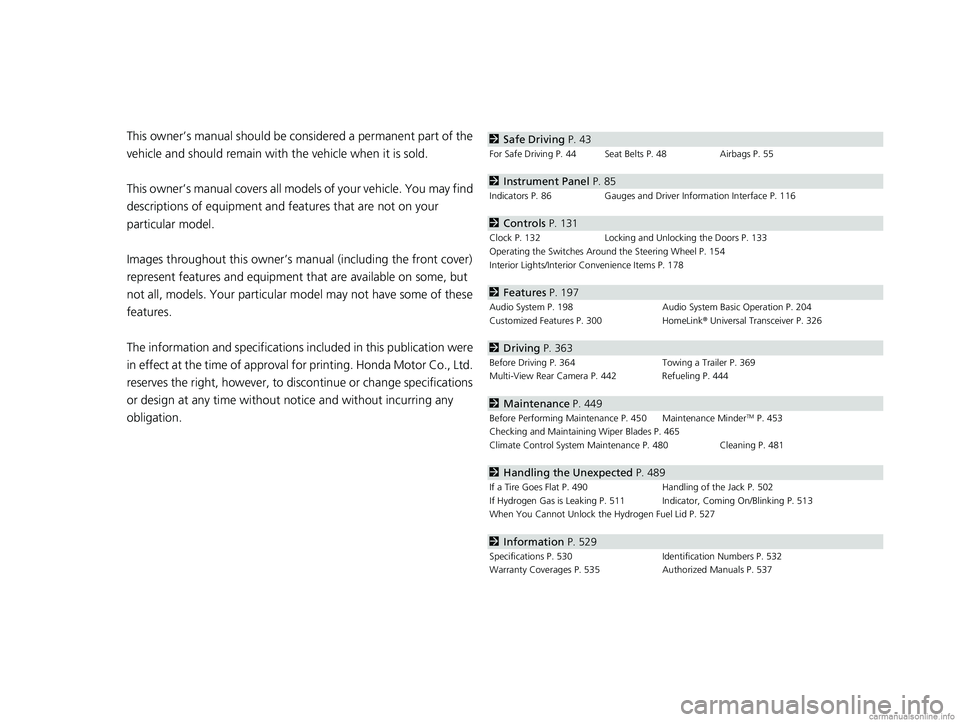
Contents
This owner’s manual should be considered a permanent part of the
vehicle and should remain with the vehicle when it is sold.
This owner’s manual covers all models of your vehicle. You may find
descriptions of equipment and features that are not on your
particular model.
Images throughout this owner’s manual (including the front cover)
represent features and equipment that are available on some, but
not all, models. Your particular mo del may not have some of these
features.
The information and specifications in cluded in this publication were
in effect at the time of approval for printing. Honda Motor Co., Ltd.
reserves the right, however, to discontinue or change specifications
or design at any time without notice and without incurring any
obligation.2 Safe Driving P. 43
For Safe Driving P. 44 Seat Belts P. 48 Airbags P. 55
2Instrument Panel P. 85
Indicators P. 86 Gauges and Driver Information Interface P. 116
2Controls P. 131
Clock P. 132 Locking and Unlocking the Doors P. 133
Operating the Switches Around the Steering Wheel P. 154
Interior Lights/Interior Convenience Items P. 178
2 Features P. 197
Audio System P. 198 Audio System Basic Operation P. 204
Customized Features P. 300 HomeLink® Universal Transceiver P. 326
2 Driving P. 363
Before Driving P. 364 Towing a Trailer P. 369
Multi-View Rear Camera P. 442 Refueling P. 444
2 Maintenance P. 449
Before Performing Maintenance P. 450 Maintenance MinderTM P. 453
Checking and Maintaining Wiper Blades P. 465
Climate Control System Main tenance P. 480 Cleaning P. 481
2Handling the Unexpected P. 489
If a Tire Goes Flat P. 490 Handling of the Jack P. 502
If Hydrogen Gas is Leaking P. 511 Indicator, Coming On/Blinking P. 513
When You Cannot Unlock the Hydrogen Fuel Lid P. 527
2 Information P. 529
Specifications P. 530 Identification Numbers P. 532
Warranty Coverages P. 535 Authorized Manuals P. 537
18 CLARITY FUEL CELL PPO-31TRT6100.book 4 ページ 2017年11月21日 火曜日 午後3時3分
Page 7 of 551
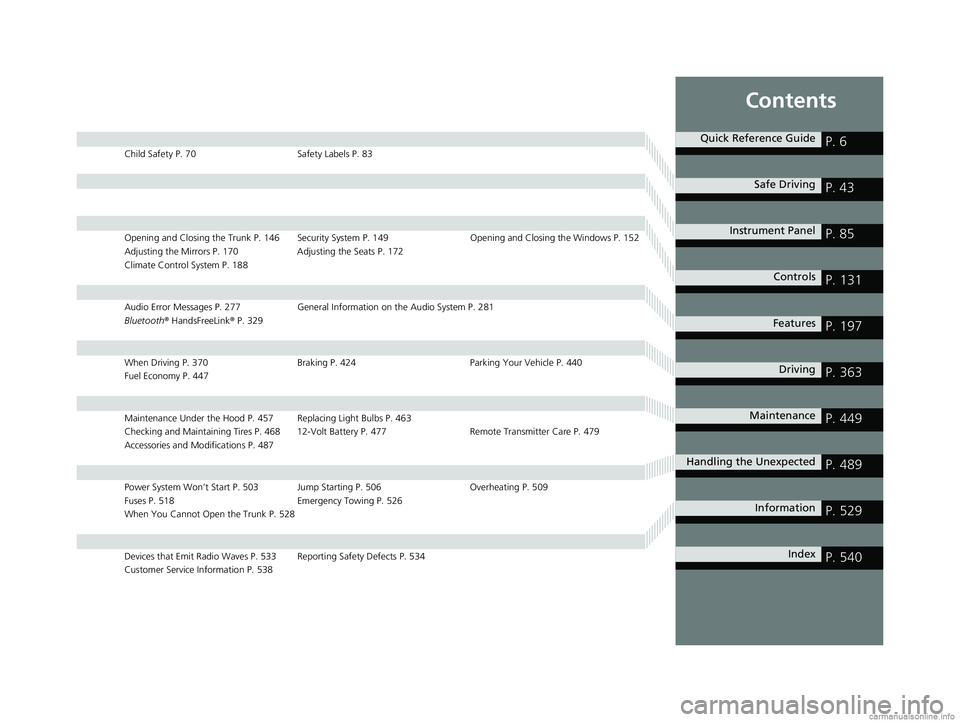
Contents
Child Safety P. 70Safety Labels P. 83
Opening and Closing the Trunk P. 146 Security System P. 149 Opening and Closing the Windows P. 152
Adjusting the Mirrors P. 170 Adjusting the Seats P. 172
Climate Control System P. 188
Audio Error Messages P. 277 General Information on the Audio System P. 281
Bluetooth ® HandsFreeLink ® P. 329
When Driving P. 370 Braking P. 424Parking Your Vehicle P. 440
Fuel Economy P. 447
Maintenance Under the Hood P. 457 Replacing Light Bulbs P. 463
Checking and Maintaining Tires P. 468 12-Volt Battery P. 477 Remote Transmitter Care P. 479
Accessories and Modifications P. 487
Power System Won’t Start P. 503 Jump Starting P. 506 Overheating P. 509
Fuses P. 518 Emergency Towing P. 526
When You Cannot Open the Trunk P. 528
Devices that Emit Radio Waves P. 533 Reporting Safety Defects P. 534
Customer Service Information P. 538
Quick Reference GuideP. 6
Safe DrivingP. 43
Instrument PanelP. 85
ControlsP. 131
FeaturesP. 197
DrivingP. 363
MaintenanceP. 449
Handling the UnexpectedP. 489
InformationP. 529
IndexP. 540
18 CLARITY FUEL CELL PPO-31TRT6100.book 5 ページ 2017年11月21日 火曜日 午後3時3分
Page 20 of 551
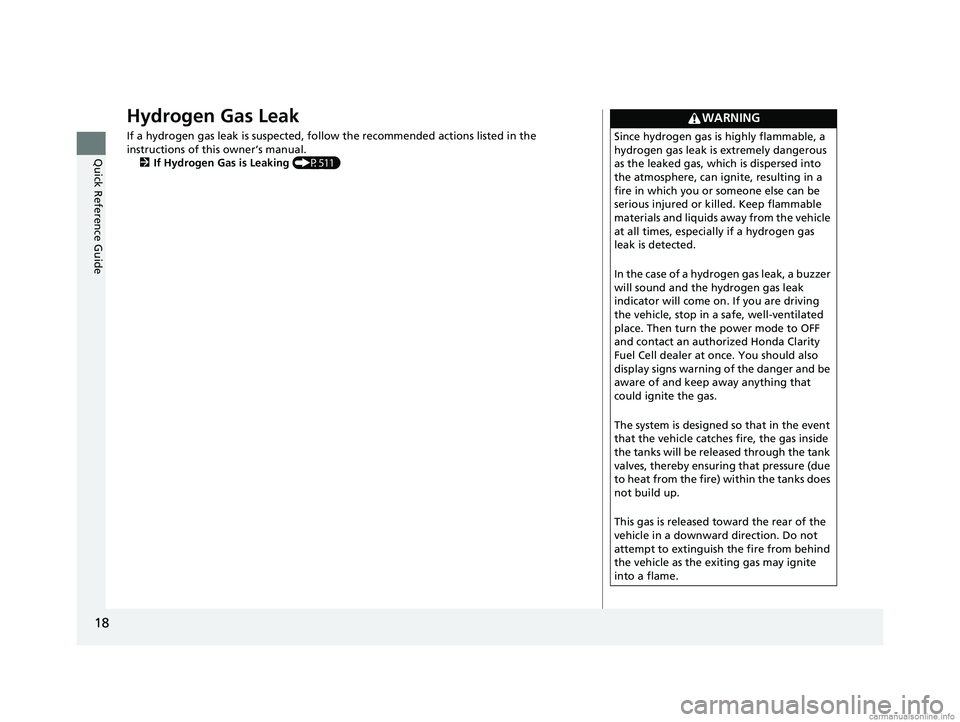
18
Quick Reference Guide
Hydrogen Gas Leak
If a hydrogen gas leak is suspected, follow the recommended actions listed in the
instructions of this owner’s manual. 2 If Hydrogen Gas is Leaking (P511)
WARNING
Since hydrogen gas is highly flammable, a
hydrogen gas leak is extremely dangerous
as the leaked gas, which is dispersed into
the atmosphere, can ignite, resulting in a
fire in which you or someone else can be
serious injured or killed. Keep flammable
materials and liquids away from the vehicle
at all times, especially if a hydrogen gas
leak is detected.
In the case of a hydrogen gas leak, a buzzer
will sound and the hydrogen gas leak
indicator will come on. If you are driving
the vehicle, stop in a safe, well-ventilated
place. Then turn the power mode to OFF
and contact an authorized Honda Clarity
Fuel Cell dealer at once. You should also
display signs warning of the danger and be
aware of and keep away anything that
could ignite the gas.
The system is designed so that in the event
that the vehicle catches fire, the gas inside
the tanks will be released through the tank
valves, thereby ensuring that pressure (due
to heat from the fire) within the tanks does
not build up.
This gas is released toward the rear of the
vehicle in a downward direction. Do not
attempt to extinguish the fire from behind
the vehicle as the exiting gas may ignite
into a flame.
18 CLARITY FUEL CELL PPO-31TRT6100.book 18 ページ 2017年11月21日 火曜日 午後3時3分
Page 23 of 551
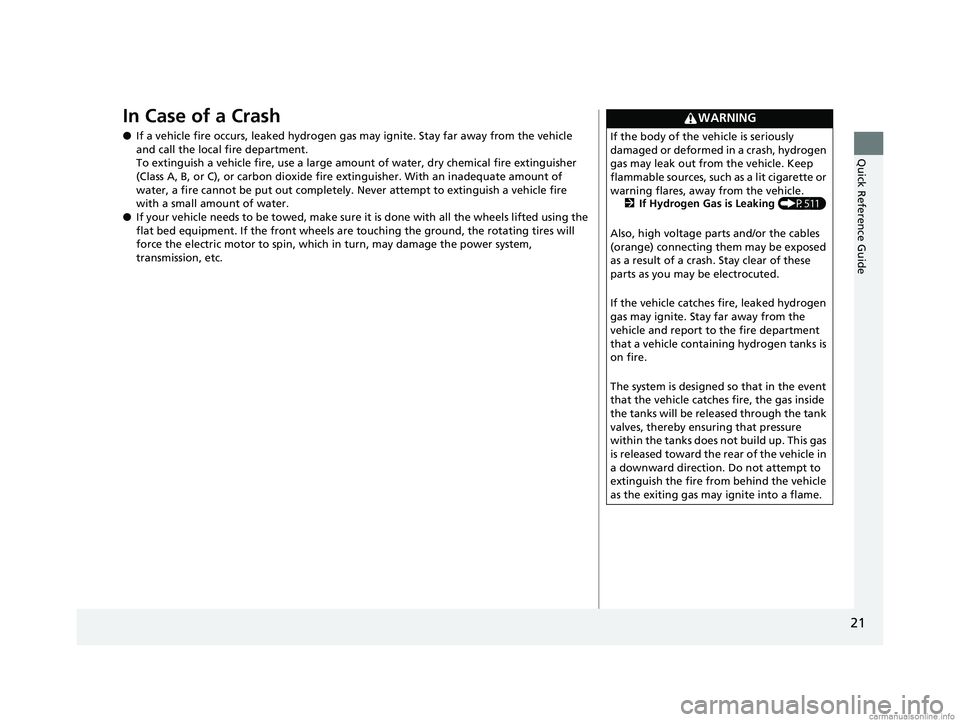
21
Quick Reference Guide
In Case of a Crash
●If a vehicle fire occurs, leaked hydrogen gas may ignite. Stay far away from the vehicle
and call the local fire department.
To extinguish a vehicle fire, use a large amount of water, dry chemical fire extinguisher
(Class A, B, or C), or carbon dioxide fire extinguisher. With an inadequate amount of
water, a fire cannot be put out completely. Never attempt to extinguish a vehicle fire
with a small amount of water.
● If your vehicle needs to be towed, make sure it is done with all the wheels lifted using the
flat bed equipment. If the front wheels are touching the ground, the rotating tires will
force the electric motor to spin, which in turn, may damage the power system,
transmission, etc.
WARNING
If the body of the vehicle is seriously
damaged or deformed in a crash, hydrogen
gas may leak out from the vehicle. Keep
flammable sources, such as a lit cigarette or
warning flares, away from the vehicle. 2If Hydrogen Gas is Leaking (P511)
Also, high voltage parts and/or the cables
(orange) connecting them may be exposed
as a result of a crash. Stay clear of these
parts as you may be electrocuted.
If the vehicle catches fire, leaked hydrogen
gas may ignite. Stay far away from the
vehicle and report to the fire department
that a vehicle containing hydrogen tanks is
on fire.
The system is designed so that in the event
that the vehicle catches fire, the gas inside
the tanks will be released through the tank
valves, thereby ensuring that pressure
within the tanks does not build up. This gas
is released toward the rear of the vehicle in
a downward direction. Do not attempt to
extinguish the fire from behind the vehicle
as the exiting gas may ignite into a flame.
18 CLARITY FUEL CELL PPO-31TRT6100.book 21 ページ 2017年11月21日 火曜日 午後3時3分
Page 30 of 551
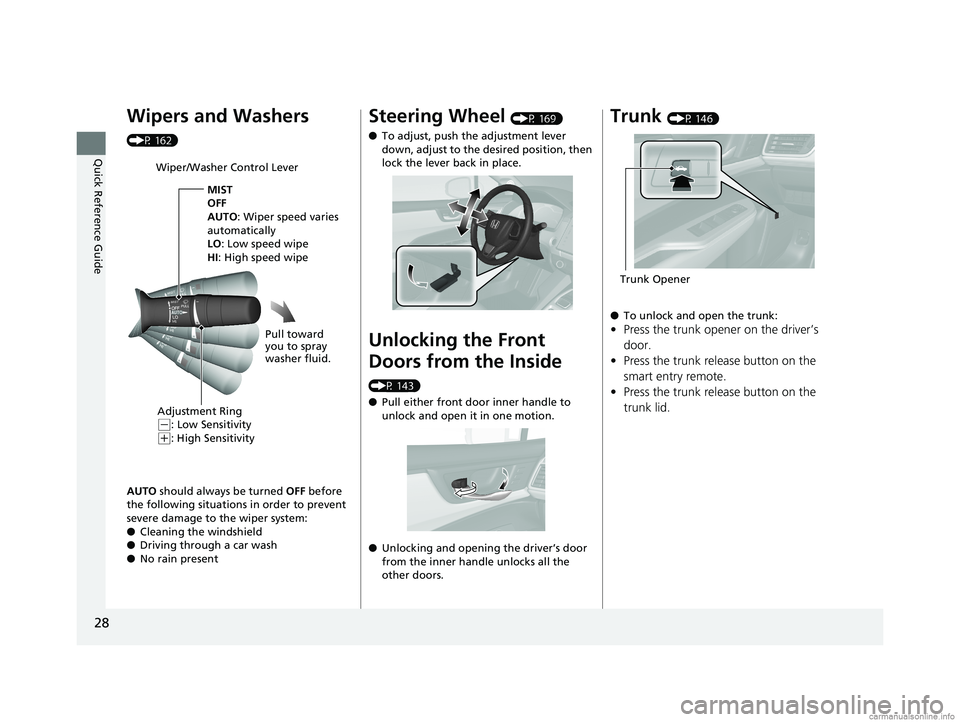
28
Quick Reference Guide
Wipers and Washers
(P 162)
AUTO should always be turned OFF before
the following situations in order to prevent
severe damage to the wiper system:
● Cleaning the windshield
● Driving through a car wash
● No rain present
Wiper/Washer Control Lever
Adjustment Ring
(-: Low Sensitivity
(+: High Sensitivity MIST
OFF
AUTO
: Wiper speed varies
automatically
LO: Low speed wipe
HI: High speed wipe
Pull toward
you to spray
washer fluid.
Steering Wheel (P 169)
● To adjust, push the adjustment lever
down, adjust to the desired position, then
lock the lever back in place.
Unlocking the Front
Doors from the Inside
(P 143)
●Pull either front door inner handle to
unlock and open it in one motion.
● Unlocking and opening the driver’s door
from the inner handle unlocks all the
other doors.
Trunk (P 146)
● To unlock and open the trunk:
•Press the trunk opener on the driver’s
door.
• Press the trunk release button on the
smart entry remote.
• Press the trunk release button on the
trunk lid.
Trunk Opener
18 CLARITY FUEL CELL PPO-31TRT6100.book 28 ページ 2017年11月21日 火曜日 午後3時3分
Page 40 of 551
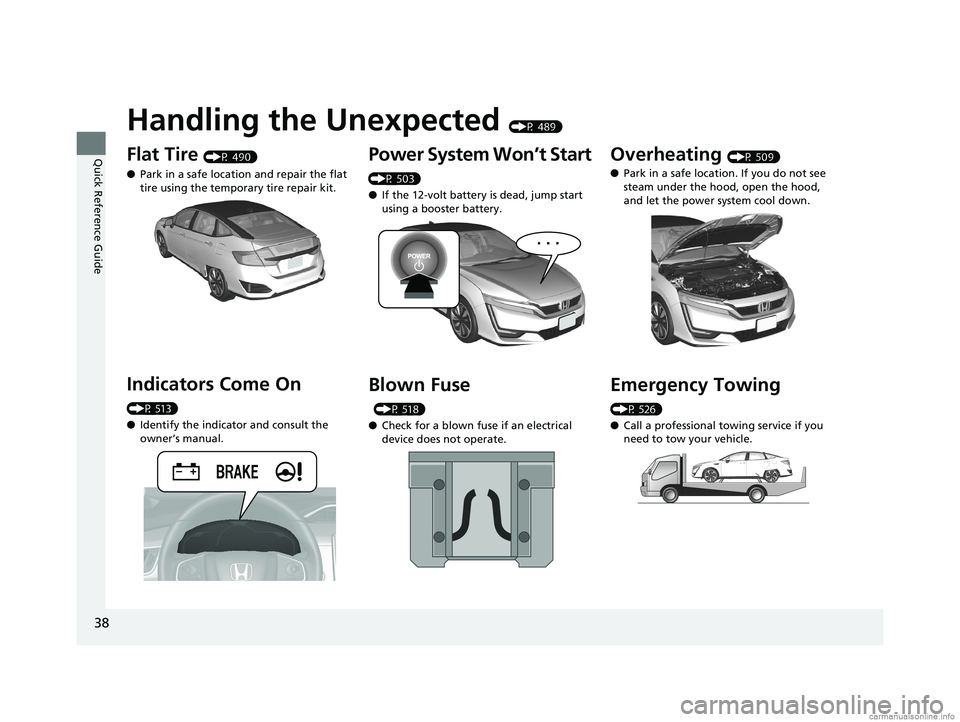
38
Quick Reference Guide
Handling the Unexpected (P 489)
Flat Tire (P 490)
● Park in a safe location and repair the flat
tire using the temporary tire repair kit.
Indicators Come On
(P 513)
●Identify the indicator and consult the
owner’s manual.
Power System Won’t Start
(P 503)
● If the 12-volt battery is dead, jump start
using a booster battery.
Blown Fuse
(P 518)
● Check for a blown fuse if an electrical
device does not operate.
Overheating (P 509)
● Park in a safe location. If you do not see
steam under the hood, open the hood,
and let the power system cool down.
Emergency Towing
(P 526)
●Call a professional towing service if you
need to tow your vehicle.
18 CLARITY FUEL CELL PPO-31TRT6100.book 38 ページ 2017年11月21日 火曜日 午後3時3分
Page 54 of 551
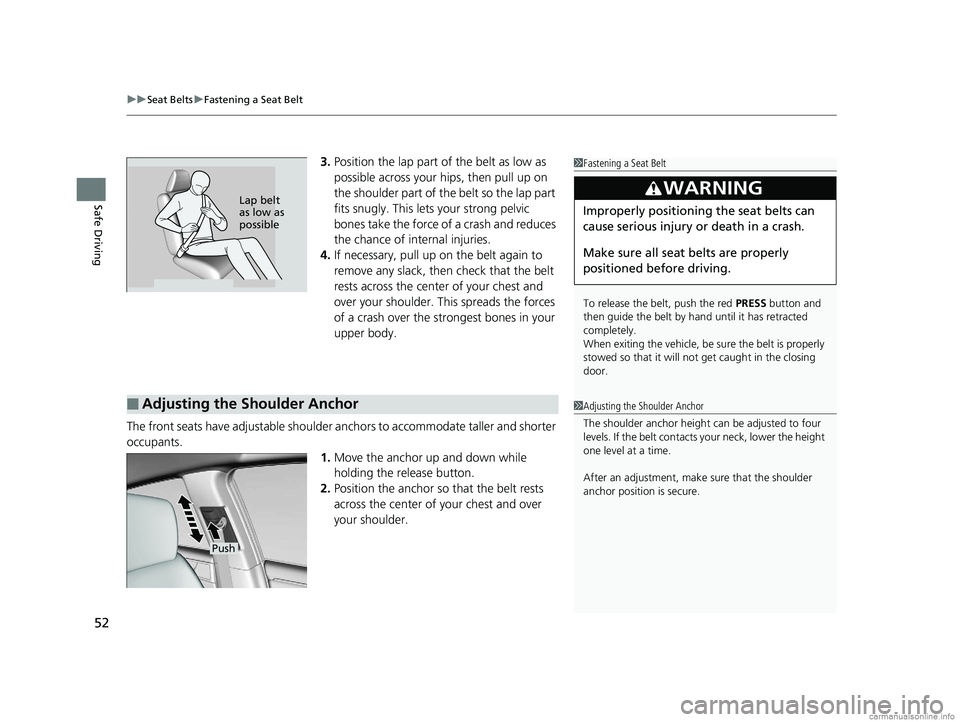
uuSeat Belts uFastening a Seat Belt
52
Safe Driving
3. Position the lap part of the belt as low as
possible across your hips, then pull up on
the shoulder part of the belt so the lap part
fits snugly. Th is lets your strong pelvic
bones take the force of a crash and reduces
the chance of internal injuries.
4. If necessary, pull up on the belt again to
remove any slack, then check that the belt
rests across the center of your chest and
over your shoulder. Th is spreads the forces
of a crash over the strongest bones in your
upper body.
The front seats have adjustable shoulder anchors to accommodate taller and shorter
occupants. 1.Move the anchor up and down while
holding the release button.
2. Position the anchor so that the belt rests
across the center of your chest and over
your shoulder.1Fastening a Seat Belt
To release the belt, push the red PRESS button and
then guide the belt by hand until it has retracted
completely.
When exiting the vehicle, be sure the belt is properly
stowed so that it will not get caught in the closing
door.
3WARNING
Improperly positioning the seat belts can
cause serious injury or death in a crash.
Make sure all seat belts are properly
positioned be fore driving.Lap belt
as low as
possible
■Adjusting the Shoulder Anchor1Adjusting the Shoulder Anchor
The shoulder anchor height can be adjusted to four
levels. If the belt contacts your neck, lower the height
one level at a time.
After an adjustment, make sure that the shoulder
anchor position is secure.
Push
18 CLARITY FUEL CELL PPO-31TRT6100.book 52 ページ 2017年11月21日 火曜日 午後3時3分
Page 62 of 551
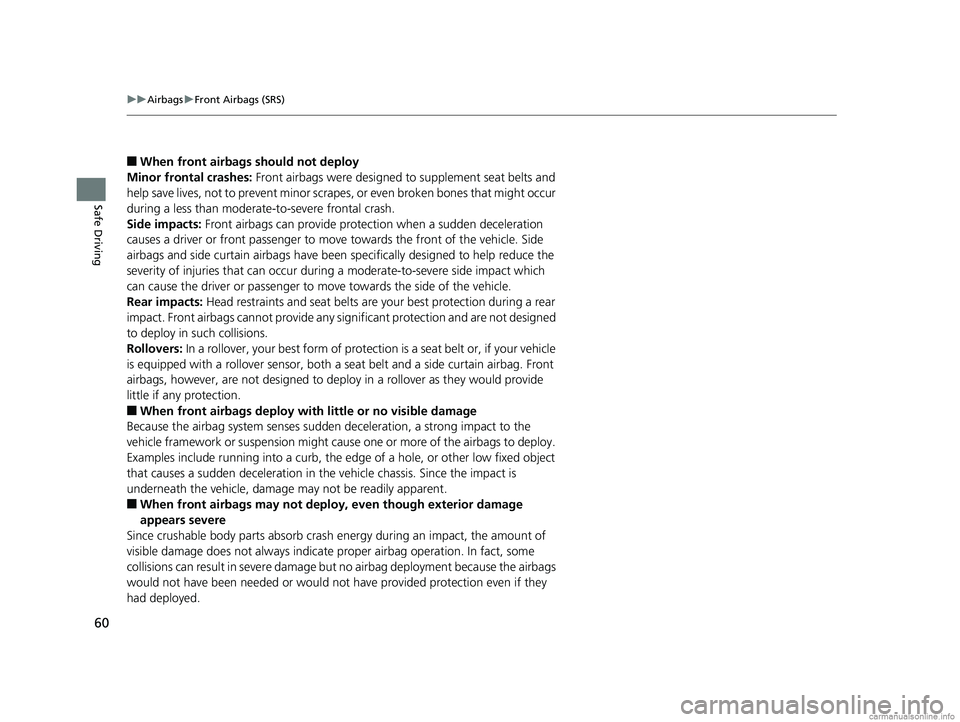
60
uuAirbags uFront Airbags (SRS)
Safe Driving
■When front airbags should not deploy
Minor frontal crashes: Front airbags were designed to supplement seat belts and
help save lives, not to prevent minor scrapes, or even broken bones that might occur
during a less than moderate-to-severe frontal crash.
Side impacts: Front airbags can provide protection when a sudden deceleration
causes a driver or front passenger to move towards the front of the vehicle. Side
airbags and side curtain airb ags have been specifically designed to help reduce the
severity of injuries that can occur during a moderate-to-severe side impact which
can cause the driver or passenger to move towards the side of the vehicle.
Rear impacts: Head restraints and seat belts are your best protection during a rear
impact. Front airbags cannot provide any significant protection and are not designed
to deploy in such collisions.
Rollovers: In a rollover, your best form of protection is a seat belt or, if your vehicle
is equipped with a rollover sensor, both a se at belt and a side curtain airbag. Front
airbags, however, are not designed to deploy in a rollover as they would provide
little if any protection.
■When front airbags deploy with little or no visible damage
Because the airbag system senses sudden deceleration, a strong impact to the
vehicle framework or suspension might caus e one or more of the airbags to deploy.
Examples include running into a curb, the edge of a hole, or other low fixed object
that causes a sudden deceleration in th e vehicle chassis. Since the impact is
underneath the vehicle, damage may not be readily apparent.
■When front airbags may not deploy, even though exterior damage
appears severe
Since crushable body parts absorb crash energy during an impact, the amount of
visible damage does not always indicate proper airbag operation. In fact, some
collisions can result in severe damage but no airbag deployment because the airbags
would not have been needed or would not have provided protection even if they
had deployed.
18 CLARITY FUEL CELL PPO-31TRT6100.book 60 ページ 2017年11月21日 火曜日 午後3時3分